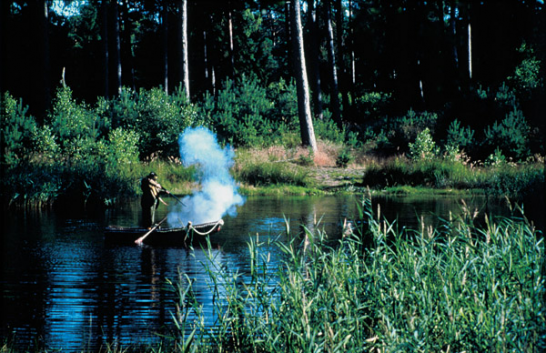| Zeitschrift Umělec 2000/3 >> The Last Hunt | Übersicht aller Ausgaben | ||||||||||||
|
|||||||||||||
The Last HuntZeitschrift Umělec 2000/301.03.2000 Karel Císař | berlin | en cs |
|||||||||||||
|
Though the Danish artist Peter Land has till now filmed his videos almost exclusively in abstract interiors, intentionally ridding them of any context of place or time, he places the story of the main character of his latest work, Lake, exhibited along with twelve photographs in Klosterfelde in Berlin, into an idyllic forest landscape. In the video, Land strolls through the forest, dressed in a hunting vest with a rifle over his shoulder. Unlike his previous videos, which used mainly static footage, Land’s action in Lake is shot like a typical film, including long takes of the trees in the forest, details of the huntsman’s steps and stylized shaky documentary-like footage taken by hand. After a while, the tired Land sits down on a stump by the road, wipes his sweaty forehead and refreshes himself with alcohol from a silver flask. He finally arrives at a dark lake, launches a boat and paddles over to a pole in the middle, attaching the boat to it. He stands up, takes the rifle off his shoulder, aims and shoots the bottom of his boat with a deafening bang that cuts through the majestic silence of the forest. He then calmly sits down and waits for the boat to fill up with water. Cut, we see water reaching up to Land’s waist and another shot shows only his hat floating on the lake’s surface. The end of this several-minute film takes us back to the deep forest through which Land was strolling just a moment ago.
One of the keys to interpreting this work could include the music. Music has played an important role in Land’s previous videos, which often show Land falling in various ways. In Manifesta 2, he tumbled down the steps of a luxurious villa, dressed in an exquisite suit. In Pink Space (1995), he spilled drunk from a barstool, while in Stepladder Blues he tipped off a decorator’s stepladder. Despite the titles of this work, his falls were not tempered by the blues but by the classical music of Richard Wagner. While Land’s huntsman strolls through the forest in Lake, we can hear Beethoven’s symphony No. 6, also known as the “Pastoral.” This choice is hardly accidental, as it strategically refers to the tradition of the idyllic image of nature in Baroque and Rococo works of art. The Pastoral constructs unreal landscapes into which we may project our nostalgia for lost original purity and innocence. Their virtue perhaps manifests itself most in the matter-of-fact way in which wild nature is filled with domestic animals. Here, paradise is full of cattle. Despite the undoubted thematic connection, Land’s huntsman does not find his longed for harmony. In his forest, he is both the hunter and the victim. In the grotesque scene on the lake, at first it seems that Land is about to catch fish with his rifle. The following scene, however, shows the forester’s true intention while, at the same time, it reminds you of the famous footage from a Buster Keaton film in which Frigo’s boat starts sinking after he launched it at a wrong angle. His intention to hunt himself shifts the meaning of the work into a completely different direction. While Land has so far only showed life degraded to the mere undetermined repetition of one activity, he seems to have now found a strong alternative. The cyclic nature of his previous works, whether made using technology—a video loop—or made naturally—through a plodding repetition of one’s own derogative activity, is now broken by his own disappearance. In the very end, the film returns to its beginning with a view of the silent forest but Land’s huntsman is no longer there. In contrast to his previous, never-ending falls, his disappearance is, in this case, irreversible. He has gone to the place of no return.
01.03.2000
Empfohlene Artikel
|
|||||||||||||








Kommentar
Der Artikel ist bisher nicht kommentiert wordenNeuen Kommentar einfügen